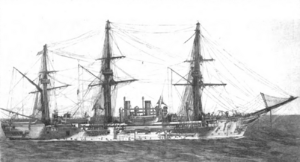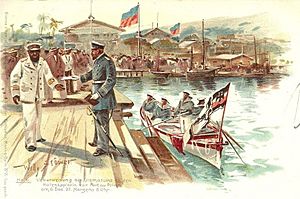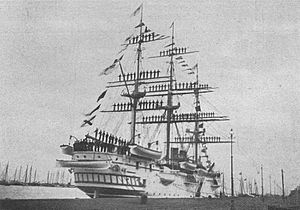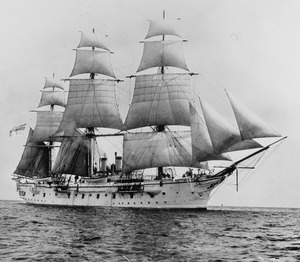SMS Charlotte facts for kids
class="infobox " style="float: right; clear: right; width: 315px; border-spacing: 2px; text-align: left; font-size: 90%;"
| colspan="2" style="text-align: center; font-size: 90%; line-height: 1.5em;" | 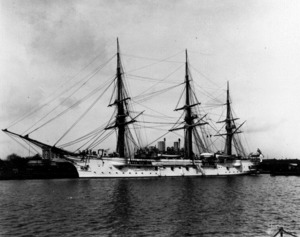
|}
The SMS Charlotte was a German screw corvette, a type of warship that used both sails and a propeller. She was built for the Kaiserliche Marine (Imperial Navy) in the 1880s. Her construction began in April 1883, she was launched in September 1885, and officially joined the navy in November 1886.
Charlotte was the only ship of her kind. She was also the very last sailing warship ever built for the German navy. She carried a powerful set of eighteen 15 cm guns. For most of her time in service, Charlotte worked as a training ship. Her main job was to train young naval cadets and apprentice sailors.
This training often meant long trips across the oceans. On one such trip in 1897, she and another ship, Stein, were involved in a diplomatic event in Haiti. This event was called the Lüders affair. Charlotte also took part in other important diplomatic visits. In 1899, she made the first visit of a German warship to French ports since the Franco-Prussian War.
The ship served until May 1909. At that point, she was removed from the navy's list of active ships. She was then changed into a barracks ship, a floating home for sailors, and a ship's tender, a support vessel. She continued in these roles until World War I began in July 1914. In August 1914, something unusual happened: she was briefly put back into active service. This was the only time in German naval history that a ship removed from service was brought back. In October, she went back to being a barracks ship. After the war, in 1921, she was sold. Her final fate is not known.
Contents
| Class overview | |
|---|---|
| Preceded by: | Nixe |
| Succeeded by: | None |
| History | |
| Name | Charlotte |
| Namesake | Princess Charlotte of Prussia |
| Builder | Kaiserliche Werft Wilhelmshaven |
| Laid down | 2 April 1883 |
| Launched | 5 September 1885 |
| Commissioned | 1 November 1886 |
| Decommissioned | 26 May 1909 |
| Fate | Sold in 1921 |
| General characteristics | |
| Type | Screw corvette |
| Displacement | Full load: 3,763 t (3,704 long tons) |
| Length | 83.85 m (275 ft 1 in) o/a |
| Beam | 14.6 m (47 ft 11 in) |
| Draft | 6.04–6.86 m (19 ft 10 in – 22 ft 6 in) |
| Installed power |
|
| Propulsion |
|
| Sail plan | 2,360 m2 (25,400 sq ft) full-rigged |
| Speed | 13.5 knots (25.0 km/h; 15.5 mph) |
| Range | 2,300 nmi (4,300 km; 2,600 mi) at 11 knots (20 km/h; 13 mph) |
| Complement | 20 officers, 486 enlisted |
| Armament |
|
Building a Unique Ship
After the Franco-Prussian War (1870–1871), the German Imperial Navy wanted to grow stronger. They needed more ships to protect Germany's growing trade around the world. They also wanted to be ready for any future conflicts. In the 1870s, Germany built many corvettes. These ships were good for long journeys but not for big battles.
In 1883, a new leader, General Leo von Caprivi, took charge of the navy. He believed new ships should be stronger in combat. However, he still approved two new corvettes that year: Charlotte and a smaller ship, Nixe.
Why Charlotte Was Built
The plans for Charlotte were made in 1881–1882. She was designed to be similar to an older ship, the Bismarck, but a bit bigger and with more powerful guns. Charlotte was built during a time of big changes in ship design. Ships were moving from relying on sails and slow-firing guns to using steam engines and fast-firing guns.
Because of this, Charlotte was a bit old-fashioned compared to other ships being built then. But the German navy still wanted to train its sailors to use sails. So, Charlotte was built with a full set of sails. This made her the last ship in the Imperial German Navy to have a full sailing rig. Even though the navy wanted stronger combat ships, Charlotte was mainly designed to be a training ship. This role suited her well.
Building Process
The building of Charlotte started on April 2, 1883. She was built at the Imperial Shipyard (Kaiserliche Werft) in Wilhelmshaven. Her launch was planned for earlier, but it was delayed until September 5, 1885. This delay happened because of budget cuts from the German parliament, the Reichstag.
At her launch ceremony, Prince Wilhelm (who later became Kaiser) named the ship after his sister, Princess Charlotte of Prussia. The ship was officially put into service on November 1, 1886. She then went through tests at sea, which finished in January 1887. However, she remained out of active service for over a year after that.
How Charlotte Worked
Charlotte was 76.85 meters (252 ft 2 in) long at the waterline and 83.85 meters (275 ft 1 in) long overall. She was 14.6 meters (47 ft 11 in) wide. Her front part sat 6.04 meters (19 ft 10 in) deep in the water, and her back part sat between 6.86 meters (22 ft 6 in) and 6.3 meters (20 ft 8 in) deep. She weighed 3,288 metric tons (3,236 long tons) normally. When fully loaded, she weighed up to 3,763 metric tons (3,704 long tons).
Her body was made with iron frames and wooden planks. These planks were covered with a special metal called Muntz metal. This metal helped stop sea creatures from growing on the hull during long trips. This was important because shipyards for cleaning were not always available far from home.
Ship's Size and Crew
The ship's crew usually had 20 officers and 486 enlisted sailors. When she became a training ship, her crew changed slightly. She carried 20 officers and 475 sailors. Among these, 50 were naval cadets and 230 were apprentice seamen.
Charlotte carried several smaller boats for different tasks. These included a picket boat, two launches, six cutters, a yawl, and a dinghy. The ship was controlled by a single rudder. She handled well in rough seas. However, she tended to drift sideways in even light winds. She was also difficult to steer. She slowed down a lot when sailing against the waves. Her performance under sail alone was limited.
Engines and Sails
Charlotte had two 2-cylinder steam engines. These engines worked together to turn a single propeller shaft with one 2-bladed propeller. Eight coal-fired boilers produced the steam for the engines. The smoke from these boilers went up two funnels that could be lowered.
The ship could reach a top speed of 13.5 knots (25.0 km/h; 15.5 mph). She could travel about 2,300 nautical miles (4,300 km; 2,600 mi) at a speed of 11 knots (20 km/h; 13 mph). When she was built, Charlotte had a full ship rig with many sails. This was to help her on long voyages. Later, her sails were reduced to a barque rig, which has fewer sails.
Between 1903 and 1905, Charlotte was updated. One engine and two boilers were removed. The remaining six boilers were replaced with newer ones. This made her top speed a bit slower, at 11.4 knots (21.1 km/h; 13.1 mph). But her cruising range increased to 4,000 nautical miles (7,400 km; 4,600 mi) at her top speed.
What Guns It Carried
Charlotte was armed with eighteen 15 cm L/22 breech-loading hoop guns. Six of these guns were removed in 1899. She carried 1,868 shells for these guns. These guns could fire up to 5,500 meters (6,000 yd).
She also had two 8.8 cm SK L/30 quick-firing guns. In addition, she carried six 37 mm Hotchkiss revolver cannon. In 1899, her smaller guns were changed. She then had two 10.5 cm SK L/35 guns, sixteen 8.8 cm SK L/30 guns, and four Hotchkiss cannons.
Charlotte's Adventures
Early Training Cruises
Charlotte began active service on September 22, 1888. She replaced another ship, Prinz Adalbert, which needed repairs. Charlotte joined the Training Squadron. She took on her first group of 50 cadets and 230 apprentice seamen.
On September 29, she left Wilhelmshaven for a training cruise to the Mediterranean Sea. During this trip, Charlotte took part in a celebration in Piraeus, Greece. This was for the 25th anniversary of King George I of Greece. The ships also visited ports in Austria-Hungary, Italy, and the Levant. They returned to Kiel, Germany, on April 16, 1889. Charlotte then moved to Wilhelmshaven and was taken out of service on April 25. She was repaired and stayed in reserve for almost ten years.
The Haiti Incident (Lüders Affair)
On April 22, 1897, Charlotte was put back into service for more training. She trained in the Baltic Sea. Then, she joined the main fleet to accompany Kaiser Wilhelm II's yacht, Hohenzollern. They visited Kronstadt, Russia, where the Kaiser met Czar Nicholas II. Later that month, Charlotte took part in the yearly fleet training.
On September 16, she began a cruise to Central America. In Charlotte Amalie, St. Thomas, Charlotte met another ship, Stein. Both ships were ordered to Port-au-Prince, Haiti. A German citizen named Lüders had been arrested and jailed there. The Haitian government would not release him, so the two German ships were sent to help. This led to the Lüders affair.
Charlotte and Stein arrived on December 6. Charlotte's commander, August Carl Thiele, gave Haiti an ultimatum. They demanded a payment of 20,000 dollars, Lüders's release, and protection for him. Haiti refused at first. The German ships prepared to fire. After a warning shot, Haiti agreed. German sailors went aboard Haitian ships to make sure they couldn't fight. Once Haiti met the demands, the German commanders visited the government. They fired salutes as a sign of good will. The United States told Germany they would act if Germany made more demands on Haiti. Charlotte left the West Indies on January 10, 1898.
Diplomatic Visits and More Training
After returning to Germany, Charlotte was repaired. Her training was stopped for a while because of an illness among the cadets. In August, she joined fleet exercises. On September 8, she began another big training cruise with Stosch. They visited islands in the Atlantic. In January 1899, they went to Tangier, Morocco. There, they made the Moroccan government pay a debt it owed.
At this time, France and Germany were becoming friends again after the Franco-Prussian War. To show this friendship, Charlotte and Stosch visited French ports in North Africa. They went to Oran, Algiers, and Tunis, where they were welcomed warmly. The ships then visited Spanish cities before returning to Germany. Charlotte arrived in Kiel on March 23.
Charlotte then went into the shipyard for updates, including changes to her guns. She made a short trip in the Baltic Sea. In July, she started her next overseas training cruise. This trip went to the southern Atlantic Ocean, reaching as far south as Rio de Janeiro. She returned to Kiel on March 23, 1900.
The ship made two short trips in the Baltic and to Norway. Then, on September 18, she began the year's main cruise to the Mediterranean. This trip included stops in Moroccan ports and Alexandria, Egypt. While in Corfu on December 17, Charlotte was ordered to Málaga. Another ship, Gneisenau, had been wrecked there in a storm. Charlotte arrived on December 22. She helped remove bodies and save valuable equipment. This work lasted until January 12, 1901. Then, Charlotte took the German ambassador from Mogador to Tangier. She visited Italian ports before returning to Kiel on March 9.
The ship had another repair in March. She returned to service on April 18. She took on cadets from the 1901 group, including Prince Adalbert, the Kaiser's son. Charlotte helped survey the Adlergrund after a battleship, Kaiser Friedrich III, ran aground there. Charlotte then cruised to Kronstadt. After that, she began another major cruise to the Mediterranean on August 14. She stopped in Piraeus, Constantinople, and Trieste. She returned to Kiel on March 16, 1902.
After another repair, she went on a training cruise in the Baltic from May 12 to July 12. Then, she started another big cruise to South America. She visited Brazil and Uruguay. Later that year, she was called to Venezuela during the Venezuelan crisis of 1902–1903. She didn't take part in fighting but supported other German warships. She left the unit on January 19, 1903, and returned home, arriving in Kiel on March 23.
Later Years and Fate
From early 1903, Charlotte received more updates. These included new boilers, the removal of her 15 cm guns, and a reduction in her sailing rig. She returned to service on April 1, 1905. On July 18, she began an overseas cruise. She visited Scotland, then sailed in the Atlantic, stopping in Mogador, before entering the Mediterranean. This cruise ended on March 30, 1906, in Kiel.
The 1906 cruise was similar to the 1905 one. During this trip, she took part in a memorial service in Málaga. This was to remember those who died when Gneisenau sank. Charlotte returned to Kiel on March 23, 1907. The rest of that year included a long cruise in the Baltic and another major trip to the West Indies. This trip lasted until March 16, 1908. The 1908–1909 cruise also went to the West Indies. During this trip, her crew helped put out a fire in Santiago de Cuba.
Charlotte, the last sailing ship of the Imperial German Navy, was taken out of service on March 31, 1909, in Kiel. She was officially removed from the navy's list of ships on May 26, 1909. She was then turned into a barracks ship and a ship's tender. She supported the old ironclad warship König Wilhelm, which was used to train cadets starting in 1910.
When World War I began in July 1914, Charlotte was briefly put back on the Navy List on October 20. This was to replace König Wilhelm, which had been moved. This was the only time a German warship that had been removed from the list was put back on it. But this didn't last long. On November 4, she was removed from service again. In 1917, a light cruiser, Medusa, replaced Charlotte as König Wilhelm's tender.
In 1921, after the war, Charlotte was sold to a private company in Hamburg. She was then used as a storage hulk, a ship that floats but cannot move, used for storage. What happened to her after that is not known.


